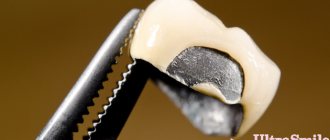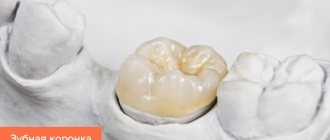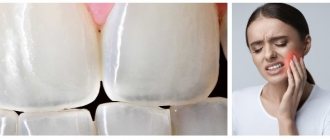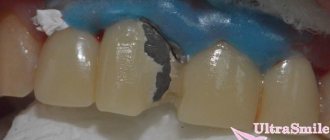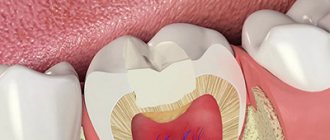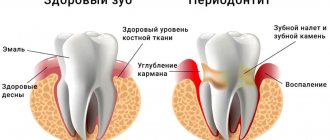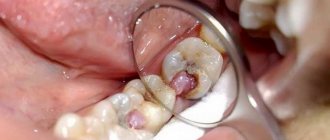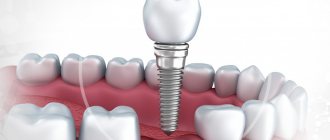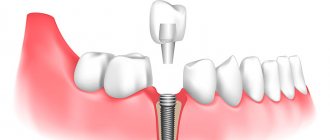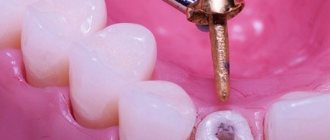June 15, 2019
Many patients are interested in the question of how to remove a crown from a tooth, because essentially the structure is permanent. However, this just means that the owner himself cannot remove it from the mouth, but the dentist, using tools and specialized equipment, will do this without difficulty. Today you will learn about how this process goes, by what methods the final result is achieved, what nuances await patients during the procedure of removing a crown from a tooth from an article prepared by journalists from the editorial office of the UltraSmile.ru portal.
What are the ways to remove a crown?
When is it necessary to remove a crown from a tooth?
Removing the crown from a tooth needs to be done only when there is a serious need for it, because the crown itself can be used for 7-10 years or more (the time period depends on the material from which the prosthesis was made).
Let us list the reasons why it is necessary to resort to such manipulation:
- a disease has developed under the structure: for example, secondary caries, periodontitis or a cyst,
- errors made at one of the stages of prosthetics: perhaps the crown does not correspond to the individual characteristics of the patient, is poorly installed and adjusted, is made of low-quality materials,
- the patient’s desire to replace the structure with a prosthesis made of a better and more beautiful material: for example, replace a metal or metal-plastic product with metal ceramics or zirconium dioxide,
- injuries that led to damage and breakage of an artificial tooth,
- destruction of permanent cement on which the orthopedic structure was fixed,
- The product has expired.
The reason for removal may be the development of caries under the crown.
If the tooth under the crown hurts, there is a bad smell, and the structure has become shaky and movable, then it is time to visit a dentist, who, based on an examination and x-ray, will decide on the need to remove and replace the artificial material.
According to numerous studies, the need to prematurely remove crowns already in the first years of use in 40% of all cases arises due to the fact that poor-quality endodontic treatment and poor-quality sanitation of the oral cavity were performed before preparing for prosthetics.
All of the above reasons are a serious reason to think about removing the prosthetic structure. Naturally, first you need to go to an appointment with a dentist, who will explain how crowns are removed from teeth. And we will look at the methods that exist today.
Price
The complexity of the process and its cost will largely depend on the material of the permanent structure and the type of device with which it will be removed.
Let's look at the average cost of techniques using the table as an example.
| Technique | Price in rubles for one prosthesis |
| Kopp apparatus | 1 000 |
| Coronaflex device | 1 500—1 800 |
| Sawing | 800 |
| Ultrasound | 900 |
Most dental clinics include in the cost of dismantling fixed structures the price for further treatment and re-prosthetics.
Method No. 1: sawing with a boron
So, let's figure out whether it is possible to remove a crown with permanent cement.
The method of removal using boron is the oldest and by far the most unaesthetic. This means that after using this tool, the sawn artificial material will only have to be thrown into the trash bin, because it can no longer be used for its intended purpose, that is, it will no longer be possible to re-prosthetize a tooth with it.
The technique is simple, cheap and quite effective, but it must be used by a doctor who has a high level of professionalism, because the approach requires caution and precision. An inexperienced specialist may damage the tooth itself or the soft tissue around it during the dismantling process.
With this method, it will not be possible to reuse the crown
“We removed the crown from the tooth with a regular bur and simply sawed it in half. There’s nothing terrible, but when the material got very hot, the smell, I’ll tell you, was not very good, plus there were slightly painful and uncomfortable sensations, even despite the fact that I had been given anesthesia before this, and the tooth itself had been under the prosthesis for a long time depulped!"
Mari, review from 32top.ru
This method is used if the patient has dentures made of inexpensive materials, which he would not mind disposing of later. The method is also suitable if the artificial structure itself is mobile or wobbly. Then it is simply sawed to the teeth, then, using special tools, the resulting edges are carefully bent in different directions and removed.
Comparison of crown removal methods:
| Method of removing structures | Operating principle | Advantages and disadvantages |
| Sawing | The dentist carefully saws the structure using a special bur. After the integrity of the crown is damaged on both sides, the product is loosened and removed. | The advantages of the method include a minimal risk of tooth damage and low cost of the procedure. The disadvantage is the need to make a new crown or prosthesis |
| Removal with a crown beater | The doctor uses a special instrument that has a working part and a handle. The working part is fixed under the edge of the crown, and sharp movements are made with the handle, the crown is separated from the tooth and removed from the mouth. | The advantages include the simplicity of the method and efficiency. The downside is the possibility of unpleasant sensations. |
| Using the Anthogyr device | The doctor treats the tooth with ultrasound to destroy the fixing cement between the tooth and the crown. Next, a special device is put on the interdental part of the structure and after several movements of the device, the crown is removed. | The advantages include a minimal risk of damage to the crown or bridge, which can be reused. |
What to do after crown removal?
After removal of structures from teeth, it is recommended to immediately make an appointment with a dentist-therapist and carry out the necessary treatment. Root canal treatment, dental caries, and professional oral hygiene may be necessary. If your teeth are sensitive, they need to be covered with temporary crowns.
In the Aesculapian dental clinics in Krasnodar, experienced dentists perform crown removal in any way; they use modern technology devices - Anthogyr (France), ultrasonic scaler. Moreover, the procedure for removing orthopedic structures is painless for patients, completely safe, and is not accompanied by tissue injury.
Contact any of the Aesculapius clinics in Krasnodar and you will be provided with the necessary dental care. Prices for removal of orthopedic structures in our clinic are listed below.
Method No. 2: using ultrasound
Are you wondering how to remove a crown from permanent cement in one of the safest and most innovative ways, and without causing any damage to it? Then ask your dentist if it is possible to use ultrasound in your case. Through impulses, the doctor acts on the cement composition, which gradually cracks. The specialist moves along the “tooth-crown” boundary; under the influence of vibrations, the cement is destroyed.
The product can be removed using ultrasound
The procedure really allows you to remove the structure in its original form, but it has a number of disadvantages. First, ultrasound has a rather gentle effect, so it is not always possible to achieve the goal the first time, and sometimes you have to visit the doctor several times. Secondly, only products that are made from not very dense materials are amenable to hardware exposure to sound waves. For example, it will not be possible to remove structures made using glass ionomers using ultrasound. Third, vibrations may be unpleasant for the patient.
Stages of preventative cleaning
In our clinic, professional cleaning is performed in the most painless and gentle way - using ultrasound and subsequent treatment of teeth with an Air Flow device.
Before the procedure, the patient must thoroughly brush his teeth with a regular brush. The dentist then visually assesses the condition of the teeth and gums.
Professional cleaning consists of the following steps:
- Removal of solid deposits using an ultrasonic device.
- Removing soft plaque using the Air Flow device.
- Cleaning interdental spaces using floss.
- Polishing teeth with special brushes, applying a fluoride-containing composition that reduces tooth sensitivity and strengthens enamel.
Ultrasound removal of tartar
Tartar adheres very tightly to the enamel; hardened plaque fills microscopic irregularities on the surface of the tooth. If you remove deposits mechanically, it is easy to damage the enamel. Chemicals that soften tartar can also worsen the condition of tooth enamel.
Therefore, an ultrasonic device – a scaler – is used to combat tartar. Using a hook-shaped scaler tip soaked in water, pry off the tartar, then turn on the ultrasound. The tip vibrates at a frequency of 30,000 vibrations per second, as a result, the water completely destroys solid deposits.
Using an ultrasonic scaler, even tartar that forms under the gum is removed, which cannot be done with mechanical instruments. The procedure does not damage the gums and tooth enamel.
Removing plaque using the Air Flow device
In order to eliminate soft plaque, Air Flow technology is used. Based on the principle of operation, the Swiss Air Flow device resembles a sandblaster. A thin stream of water with soda particles is applied under pressure to the teeth.
Soft plaque is washed out from all hard-to-reach places. After cleaning with the Air Flow device, the dentist flosses the spaces between the teeth.
Method No. 4: Kop (Koch) apparatus
This is a tool that again has a hook at the end. However, the device is not launched mechanically, but using a button, which breaks the cement along the edge of the crown using small shocks or a shock wave, after which the structure begins to move from its place. Next, the doctor can only use special forceps that hook and help to finally remove the prosthesis.
See what the Koch apparatus for removing crowns looks like in the photo.
This is what the Koch apparatus for removing crowns looks like
This device is more convenient and efficient than a manual device; it allows you to remove the product with virtually no damage and “works” quickly. However, it also has disadvantages. In particular, many patients note that during the procedures they feel “twitching” and discomfort. Also, some people are very concerned about the noise that the device makes. There is one more drawback - the device can damage the ceramic coating of the crown, leaving chips and cracks, and then the structure will have to be restored.
Kopp apparatus and other crown removers for removing bridges and crowns
Fixed dentures need to be redone every 5-7 years.
If they are firmly fixed, it can be difficult to remove them from the mouth; in such cases, the help of specialized devices is required - dental crown and bridge removers. A fixed denture remover is a device that helps remove a dental crown or bridge without compromising the integrity of dental tissue. It helps to mechanically separate the cement from the dentin, after which the prosthesis can be easily removed by hand. The crown remover is made of medical stainless steel and is easily subject to disinfection cleaning and sterilization by any available method (autoclaving, treatment in a dry-heat oven).
Method No. 5: using the Coronaflex device
The device looks like a pistol, and its operating principle is based on compressed air, which escapes from the device under pressure and breaks the cement. At the same time, this device does not have any negative effect on the artificial material of the structure or on the soft tissues of the patient.
The Coronaflex device is not available in every dentist today, so the procedure with it will be more expensive compared to other methods. However, it makes sense to use the device if you have a zirconium dioxide crown, which can be reinstalled after, for example, the tooth under the structure is cured. In addition, the procedure using this device is more comfortable, safer, and requires less time to solve the problem. Also, according to patient reviews, the device makes virtually no noise, which allows you to feel comfortable in the dentist’s chair.
The Coronaflex device removes the crown quite comfortably
CEREC Sirona (Germany)
The CEREC crown manufacturing system is a revolutionary breakthrough in the field of prosthetic dentistry. This system consists of several devices, including a computer station and a special milling robot, which makes it easy to produce a completely finished crown within 30 minutes. The device uses special ceramic blocks as blanks, from which it mills a finished crown according to a given model.
The crown is made in almost the same way as the inlay. First, the patient’s tooth is scanned using a 3D scanner, after which the system selects the most suitable one from a library of different tooth shapes for a particular patient, taking into account his individual characteristics. The doctor adjusts the shape of the tooth as necessary, and then sends the model for processing. The finished crown is made quite quickly - literally in 10 minutes. After this, the device covers the machined crown with enamel that matches the color of your own teeth. The CEREC crown is a unique product. It is manufactured quickly, efficiently and is highly accurate. It requires practically no fittings, and is even cheaper than a classic zirconium crown. Perhaps this was due to the fact that the entire process is automated, and the material used is cheaper than analogues.
From the moment the patient arrives at the dentist until the moment the crown is already installed, only 2 hours can pass, that is, when using the CEREC system, there is no need to split the treatment process into several appointments.
Is it possible to remove a crown at home?
If you are interested in the question of how to remove a crown from a tooth at home, then the answer will be clear: you cannot do this at home. This procedure should only be performed by a professional dentist. For those who neglect this rule, everything can end sadly: there is a risk of damaging not only the artificial material, but also injuring the soft tissues and the tooth itself, which is located under the crown.
You can try to remove the structure yourself only if it has come unstuck and started to loosen, or if it has fallen apart or split, and there is a need to remove the remaining fragments of the product, which can injure the mucous membrane or antagonist teeth. But it’s better if you rush to see a dentist even in such situations.
If the structure comes unstuck, you can remove it yourself
If the materials from which the crown was created, as well as the cement, have expired, and you do not rush to the dentist, then an unpleasant situation may await you. For example, artificial material can be swallowed. What to do in such situations, read the material “5 useful tips for those who have swallowed a crown.”
About pain and self-liquidation
The level of complexity and pain of each of the listed methods depends on the experience and professionalism of the doctor.
If the removal of the structure involves the destruction of the cement base, the crown easily falls out, such manipulation is easy and painless.
If a fixed prosthesis is installed firmly and stably, and dismantling requires maintaining the integrity of the product, the duration of the procedure increases, which causes discomfort in the patient. In such cases, the use of anesthesia is appropriate .
If there is severe pain under the structure, a person looks for forced ways to eliminate the product at home. Lack of experience and special equipment are considered to be the cause of adverse consequences.
Any attempts to independently remove the prosthesis lead to its damage or injury to the soft tissues of the oral cavity.
For this reason, such manipulations are carried out in a clinical setting. A qualified doctor with special equipment will perform correct crown removal.
You can remove the orthopedic device yourself in two cases:
- the product has become loose or has come off together with the cement base;
- the structure fell apart and it became necessary to extract the remaining fragments.
To avoid further complications, a person should seek help from a specialist as soon as possible.
Is it possible to cure a tooth without removing the crown?
The question is very relevant, because usually, after removing a structure, it can rarely be reused for its intended purpose, therefore, you have to pay money for the manufacture and installation of a new prosthesis. Fortunately, today in some cases you can do without removing the structure. For example, if it is necessary to cure recurrent caries or remove a small cyst, the doctor may perform endodontic manipulations through a small hole made in the crown or through an incision in the gum (to remove the cyst). After the procedures, this hole will be masked with a composite material, and the sutured gum will need time to heal.
In some cases, modern technologies make it possible to cure a tooth without removing the crown.
However, you need to understand that in order to safely and effectively carry out such jewelry manipulations, the doctor must be a professional. In addition, the patient himself should seek help when the problem is still minor and the inflammatory process has not gone too far. To do this, it is necessary to undergo preventive examinations, because the more minor the problem, the easier it is to solve it with therapeutic methods, without resorting to drastic measures.
Notice
: Undefined variable: post_id in
/home/c/ch75405/public_html/wp-content/themes/UltraSmile/single-item.php
on line
45 Notice
: Undefined variable: full in
/home/c/ch75405/public_html/wp-content /themes/UltraSmile/single-item.php
on line
46
Rate this article:
( 6 ratings, average: 5.00 out of 5)
crown
- Lutskaya I.K., Zinovenko O.G. Frequency of development of caries in teeth covered with artificial crowns.
Indications for removing the structure
Installing a crown is a long and laborious process, sometimes painful. The situations and reasons for removing dental structures must be quite compelling. After all, not every patient will agree to be in the dental chair again to correct the problem that has arisen. Conventionally, several reasons can be identified for the elimination of a fixed orthopedic product.
Toothache or bad odor
The need to treat a tooth hidden under a prosthesis and neighboring teeth to which access is blocked. There may be various reasons:
There are situations when removal of a fixed prosthesis is not required. The necessary manipulations to eliminate pain are carried out by drilling a hole in the structure, through which all the required therapeutic manipulations are directly carried out.
After the procedure, the hole is cemented. The service life of the prosthesis is reduced. Removal is carried out only in extreme cases, when there is no other way to reach the affected area and relieve the patient from pain.
Poor crown fixation
Poor fixation or loss of stability of the product most often occurs due to the following reasons:
- making a mistake when installing the base of the prosthesis;
- use of low-quality cementing material;
- destruction of the filling connecting layer.
It is easy to notice such a symptom, because the tooth begins to loosen and cause inconvenience when talking and eating.
Inflammation and gum disease
Periodontal problems arise for various reasons: from the onset of the inflammatory process to injury due to a negligent approach to the manufacture and installation of the product. In such a situation, the prosthesis puts pressure on the gingival margin, rubs, and the inflammatory process gradually begins. The patient needs to dismantle the structure with subsequent treatment of soft tissues damaged due to the pressure of the prosthesis on the gums.
Other reasons
Repeated prosthetics may be necessary if the patient himself desires it for his own reasons (to change the prosthesis to a better, reliable and attractive one), or due to the expiration of the product’s service life. There is a need to replace the structure due to damage and deformation (if the bridge is cracked, repair is not possible in most cases).
Comments
Good afternoon. My metal-ceramic bridge on one tooth became movable. It is possible to remove the bridge without damage in order to reuse it. Thank you.
Svetlana (06/18/2019 at 11:25 am) Reply to comment
- Dear Svetlana! As a rule, no, the bridge is completely removed (you need to saw it). In addition, it is fixed on at least 2 supporting teeth, which apparently have become unusable.
Editorial staff of the portal UltraSmile.ru (06/21/2019 at 12:23 pm) Reply to comment
Tell me, how do you remove the crown from the implant?
AlinaR. (06/22/2019 at 17:29) Reply to comment
- Dear Alina! There are two extraction methods here, and which one to use will depend on how the crown is attached to the implant. If the fixation was screw (which is more preferable), then the doctor will simply unscrew the screws connecting the crown, implant and abutment. If the fixation was cement, then the specialist will use the cutting method - others are not suitable for implantation.
Editorial staff of the portal UltraSmile.ru (06/25/2019 at 09:19) Reply to comment
Which doctor should I go to to have my crown removed?
Makar (06/30/2019 at 10:02 pm) Reply to comment
- Dear Makar! This manipulation should be performed by an orthopedic dentist.
Editorial staff of the portal UltraSmile.ru (07/03/2019 at 09:17) Reply to comment
Is this procedure, removing a crown from a tooth, painful?
Arfa (07/18/2019 at 04:47 pm) Reply to comment
- Good afternoon This procedure cannot be called pleasant and comfortable, but it is painless, because... the doctor applies anesthesia. In addition, in most cases, crowns are used to replace already pulpless teeth that do not have a nerve. Pain and discomfort can only occur if inflammation has begun under the crown. Then pain can be felt not only in the tooth itself, but also in the soft tissues surrounding it.
Editorial staff of the portal UltraSmile.ru (07/26/2019 at 09:33) Reply to comment
Will my tooth hurt after the crown is removed?
Vedeneeva Victoria (05.08.2019 at 19:05) Reply to comment
- Dear Victoria. A tooth can only hurt if it has developed periodontitis or granuloma. Less often, pain occurs because the crown removal procedure was carried out by a not very professional doctor, who could injure the gums or mucous membranes, or damage the tooth itself.
Editorial staff of the portal UltraSmile.ru (08.08.2019 at 09:25) Reply to comment
Tell me, what if the crowns do not fit tightly to the gums on the back side, where is the palate? is this normal? that is, the tricrowns on the right entered the cast gums; three crowns _and the other three on the back side I feel their edges with my tongue….
san (01/09/2021 at 04:13) Reply to comment
a metal-ceramic bridge costs 10 months on one side it moves away and sways I was at the doctor’s appointment and the answer was swing the entire bridge and come what to do
Natalia (09.12.2021 at 18:51) Reply to comment
Write your comment Cancel reply
Following actions
After removal of the orthopedic product, the patient may experience discomfort and pain.
To identify the cause of pain, a specialist examines the condition of the tooth. In some cases, radiography is performed for an accurate diagnosis.
The doctor’s algorithm for further actions will depend on the situation as a result of which the crown had to be removed:
- Treatment of the inflammatory process. In the presence of diseases such as pulpitis, caries and periodontitis, the root canals of the tooth are unfilled.
Next, the doctor’s task is to prevent the pathological process in tissues using anti-inflammatory therapy. At the last stage of treatment, a filling is installed. - Restoration. To prevent subsequent destruction of the crown if it is damaged or chipped, restoration measures are required.
- Replacement of cement when it is destroyed . Here it is important to quickly treat the stump with antiseptic agents and re-fix the prosthesis using new dental cement.
- Replacement of the structure at the request of the patient or if it is impossible to reuse it .
Using an x-ray, the doctor evaluates the quality of filling the dental canals, as well as the condition of the periodontal structures. After this, you can select and order a new design.
The therapeutic course of treatment includes the following procedures:
- to fight infection and eliminate inflammation, the patient is prescribed medications from the group of antibiotics;
- Rinsing the mouth with decoctions of medicinal herbs and Furacilin solution is effective;
- To reduce pain, dentists recommend using anti-inflammatory compresses with an analgesic effect.
A paste made from 1 tablet of Nurofen and a few drops of boiled water has worked well here. It is rubbed into the wound area.
In rare cases, the tissue under the crown becomes permanently damaged and cannot be saved. Under such circumstances, the doctor warns the patient about the extraction of the tooth from the alveolus and the impossibility of re-fixing the crown.
As an alternative, you can choose another prosthetic option or resort to implantation.
Stock
-9%
BASAL COMPLEX - Restoration of teeth on 1 jaw in 3 days 330,000 rub.
300,000 rub.
get -43 %
Dental implantation RUR 20,000.
35000 rub. 20,000 rub.
get -27 %
Teeth in 1 day on Straumann implants using ProArch technology!
300,000 rub. 220,000 rub.
get -13 %
Removable overdenture on 4 implants RUB 150,000.
130,000 rub. get
Indications for removing the structure
Crowns are removed for various reasons, the main ones being pain under the structure, bad breath, dental diseases, and destruction of cement. Sometimes the patient wants to remove the structure for his own reasons, for example, to replace it with a better one or one that is more aesthetically pleasing. Another indication is the expiration of the service life.
Pain or bad odor
Sometimes an incorrectly manufactured or installed prosthesis puts pressure on the gum and rubs it, resulting in an inflammatory process (see also: how to treat the gum if it is rubbed with a prosthesis?). In this case, the crown must be removed and replaced with a new one.
The cause of pain can also be diseases, which will be discussed below. To avoid complications, you should consult a specialist in time.
Insufficient crown fixation
Crown disintegration is a common phenomenon. It is difficult not to notice it: the structure begins to loosen and causes discomfort during conversation and when eating. Usually the problem occurs due to a mistake by the dentist during the cementing process, or when using a low-quality bonding material.
How to remove crown dentures in dentistry
As for which doctor removes crowns from teeth, it needs to be clarified that such a procedure falls within the competence of both orthopedists and endodontists. At the same time, today specialists have at their disposal different methods for extracting such structures - let’s look at them in more detail.
Cutting the prosthesis using a bur
The classic option for dismantling a single prosthesis. The artificial material is literally sawn apart and then carefully removed, but the product is no longer suitable for re-prosthetics. This is a simple and accessible method, which, however, requires sufficient experience and skill from the doctor, since all actions must be performed as carefully as possible so as not to injure the living tissues of the tooth and the adjacent mucous membrane.
This is how a prosthesis is cut using a bur
This option is suitable if you need to remove a budget crown model, which you would then not mind sending for scrap. This method is also recommended in cases where the product is already damaged or wobbly. The doctor cuts the structure until it meets the dental tissues, after which, using hand tools, he bends its edges in opposite directions and takes out the denture in parts.
Removal using ultrasound
One of the fastest, safest and most modern methods of removing an artificial crown involves the use of ultrasound. By directly affecting the cement composition, ultrasonic waves lead to the destruction of the binder material. This approach allows you to remove the product without the slightest damage, but the technique also has its drawbacks. Thus, ultrasonic vibrations reproduce a gentle, but too soft effect, which may not always lead to the desired result the first time. In some situations, the patient has to visit a specialist several times.
Ultrasound can also be used to remove the product.
Another point is that this hardware method allows you to remove products made from materials that are not too dense. For example, glass ionomer structures cannot be removed using ultrasound1. In addition, many patients note that ultrasonic vibrations in the oral cavity do not cause the most pleasant sensations, which may be associated with some discomfort during the procedure.
Manual crown remover
Here we are talking about a special tool with metal hooks attached to the end. It is with these hooks that the doctor carefully picks up the edges of the prosthetic structure and pulls it. The shock wave, combined with the force applied by the doctor, leads to the destruction of the cement base, thanks to which the specialist is able to carefully remove the product from the oral cavity.
The photo shows a manual crown remover
Application of the KOPPA (Koch) apparatus
The device in the form of a tool is somewhat similar to a crown remover. There is also a small hook at the end, but this device is activated using a button. It provides a mechanical effect leading to the destruction of cement along the edge of the prosthetic device. As soon as the structure becomes mobile, the doctor takes special forceps and uses them to remove the prosthesis from the oral cavity.
The photo shows the COPP (Koch) apparatus
The use of the KOPP apparatus makes the procedure simpler and less traumatic. However, this method also has its drawbacks. For example, during dismantling, the patient may experience some discomfort due to the twitching of the instrument, which is clearly felt in the mouth. In addition, the device makes a not very pleasant sound. Another disadvantage is that the device can damage the integrity of the ceramic coating, leaving cracks and chips on it, in which case the product will have to be repaired.
"Coronaflex" - a modern approach
This device resembles a pistol in appearance. The air in it is in a compressed state and, after activation, comes out under high pressure, as a result of which the structure of the cement base on which the crown rests is destroyed. At the same time, the prosthesis itself remains intact and intact, as does the surrounding mucosa.
“Immediately after installing the crown, the doctor warned me: if you don’t want problems in the near future, brush it constantly like your teeth and it’s better to buy an irrigator. By the way, it’s a cool thing, very convenient, I recommend it to everyone. But my brother just recently had it removed with coronaflex. According to him, the procedure was not the most pleasant, although it was performed with anesthesia. There was no pain, but it didn’t feel very comfortable.”
Leha1991, from correspondence on the forum www.32top
A more modern device is Coronaflex
. Not every dental clinic has such a device. The procedure using it will cost an order of magnitude more than dismantling using the methods described above. This approach is recommended for the extraction of expensive products, for example, zirconium. Subsequently, such a single prosthesis can be used again to hide the dentition defect. Patients note that the procedure takes place in more comfortable conditions, and doctors praise the device for its ease of use and speed of extraction.
